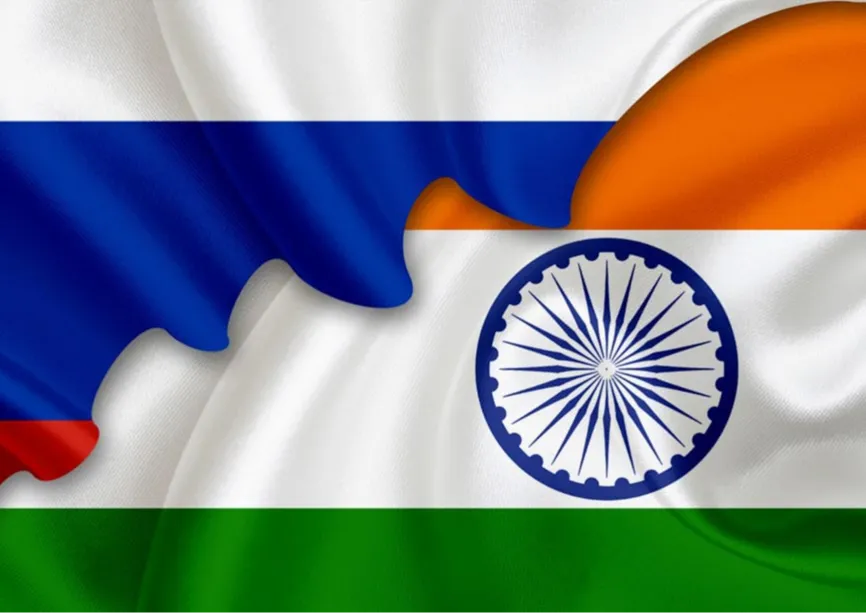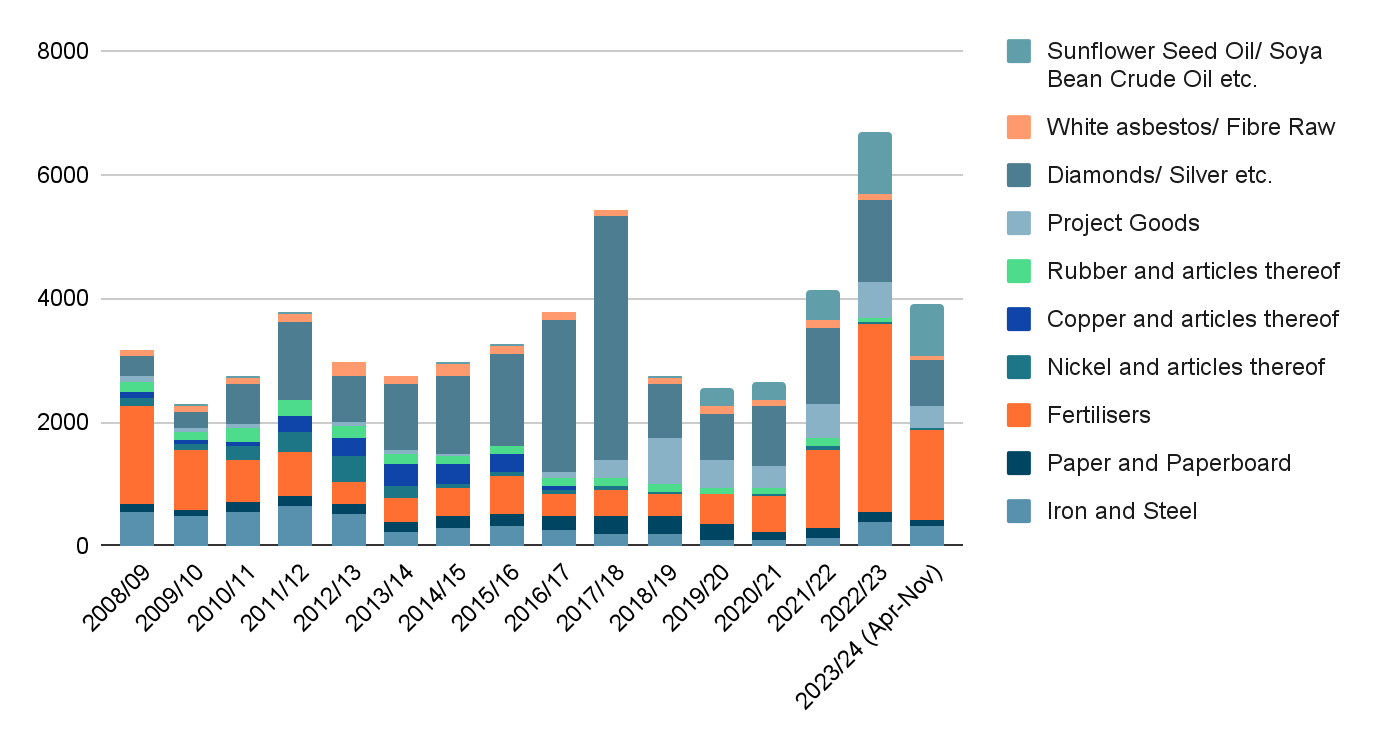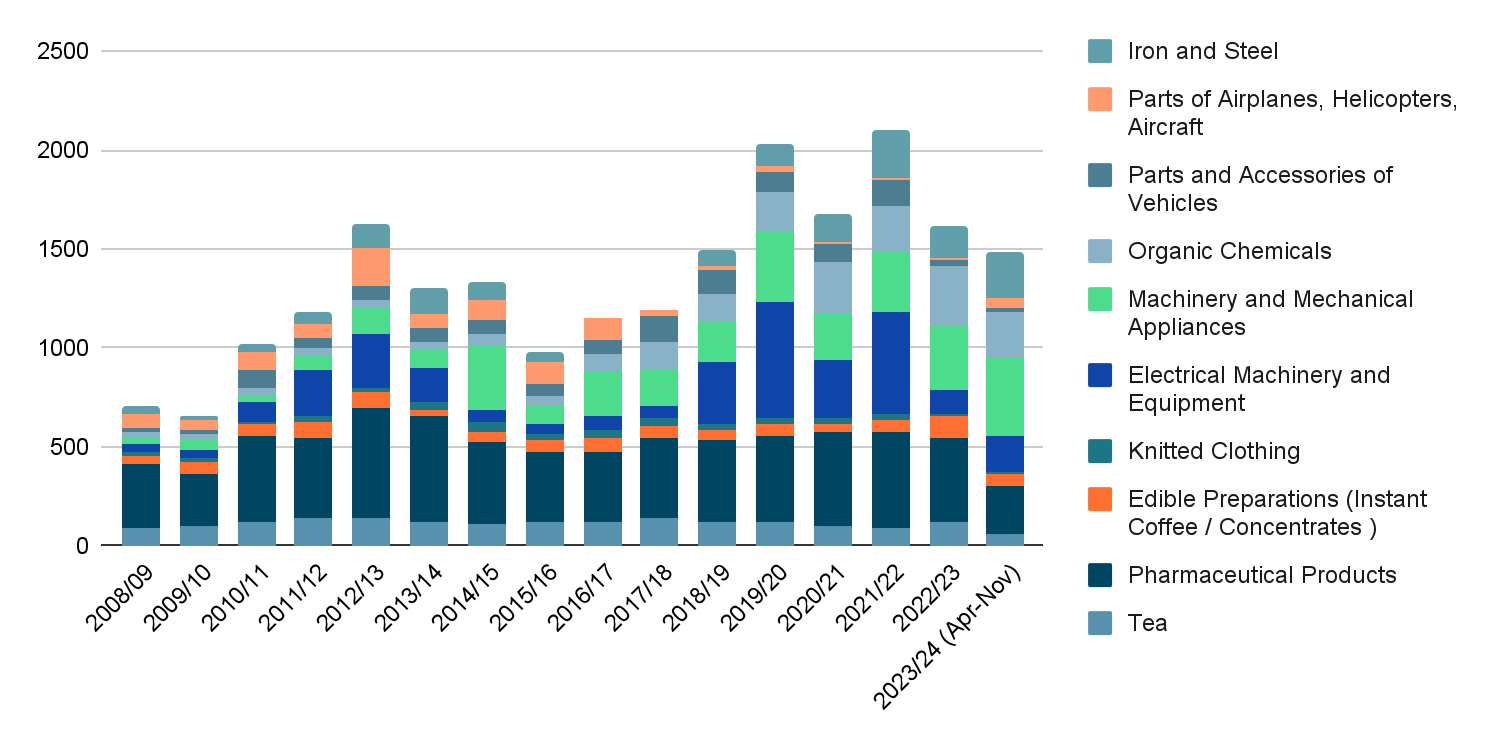-
CENTRES
Progammes & Centres
Location
India-Russia relations need a paradigm shift in the relationship from a “seller-buyer” format to a more strategic foundation

Since 2010, the India-Russia special and privileged strategic partnership has developed on a solid foundation of strong history and was maintained by the means of political imperatives. Russia supported India’s membership in the Shanghai Cooperation Organisation (SCO) and called for the reform of the UN Security Council and India’s inclusion into this group, thus, broadly acknowledging India’s rising role in the international arena.
Over the last decade, Russia’s ‘Turn to the East’ policy has signalled aspirations for recalibration of its economic relations with Asian countries to counterbalance the economic entwinements with the European Union (EU). However, the velocity and scope of the shift were highly determined by the ability to maintain economic ties with the West, that would suit every party. The intricate interplay between the ability and the desire in Russia’s foreign policy became distinctly noticeable two years ago, shortly after the events of 24 February. The conflict in Ukraine, serving as an inflection point, galvanised Russian political elites to diversify and cast their gaze towards India.
Russia’s ‘Turn to the East’ policy has signalled aspirations for recalibration of its economic relations with Asian countries to counterbalance the economic entwinements with the European Union (EU).
Previously, both India and Russia were sluggish in converting political rapport into tangible economic cooperation with the bilateral trade languishing. Except for traditional domains of cooperation in military and energy spheres, the Russian and Indian business was dormant and highly reluctant to take decisive steps towards each other. Nowadays despite the certain adaptability of commercial relations, ubiquitous apprehension amid political and economic uncertainties resulted in the intermission of much-desired strategic projects, such as the International North-South Transport Corridor (INSTC) and Free Trade Agreement (FTA) between India and the Eurasian Economic Union (EAEU). This state of affairs significantly constricts the room for manoeuvre.
The developments which accompanied the current decade amplified the voices of those who advocated for self-reliance and import substitution. The COVID-19 pandemic has provoked disruptions in supply chains, particularly affecting the production of in-demand electronics, thereby fuelling a resurgence of protectionism sentiments. Shortly afterwards, the conflict in Ukraine, along with tensions in Russian relations with the West, resulted in a short-term but very palpable surge in energy prices and fertiliser costs also affecting global markets of agricultural products, notably corn, barley, wheat, and sunflower oil.
At the same time, the unfolding events became a litmus test for the resilience of India-Russia economic ties. In 2019, both nations set an ambitious goal to increase the level of bilateral trade from US$10 billion. to US$30 billion. by the end of 2025. The target was surpassed in the 2022-23 financial year, with total legal trade soaring to US$49 billion, propelled by the sixfold increase in imports of Russian oil at discounted rates. This accounts for 62.8 percent of bilateral trade and 19.2 percent of India’s total oil imports. By far the data shows that the numbers are likely to be transcended in the upcoming year. From April to December 2023, India procured Russian oil amounting to US$34.4 billion., constituting almost 34 percent of all crude oil imports. The robust performance underscores a remarkable adaptability to untoward conditions and secondary sanctions since a considerable share of trade is conducted through ‘shadow fleet’ and ‘grey zones’ of international maritime trade as well as third parties such as Singapore, the United Arab Emirates and Türkiye. The Indian ports of Sikka and Vadinar have become the largest pivotal hubs for receiving Russian oil.
The robust performance underscores a remarkable adaptability to untoward conditions and secondary sanctions since a considerable share of trade is conducted through ‘shadow fleet’ and ‘grey zones’ of international maritime trade as well as third parties such as Singapore, the United Arab Emirates and Türkiye.
On the one hand, the status quo appears to be mutually beneficial, offering a sense of reassurance to both parties. India’s imperative to bolster its energy security is paramount, given that a mere US$1 per barrel increase in crude oil prices may lead to an annual uptick in the current account deficit of approximately US$2 billion. On top of that, the country gains substantial profit from the oil refining sector and exportation of petroleum products to European markets.
To this extent, the volume of Indian export of diesel fuel to the Netherlands experienced several-fold increase and constituted US$12.5 billion and to Türkiye by 54 percent, exceeding US$3 billion. Similarly, shipments of diesel oil and kerosene constitute two main categories of India’s exports to France, amounting to US$1.2 billion. “The world is grateful to India for buying Russian oil”, the recent remark made by Hardip Singh Puri, vividly reflects the case[1].
However, this tranquillity may be misguided, as this situation renders bilateral trade very susceptible to exogenous factors, i.e. market fluctuations and politically motivated decisions. Consequently, this often leads to more complex logistics and higher prices for consumer products. Amidst a gradual but discernible drift towards the American technological lagoon, Indian companies are becoming cautious about engaging in collaborations with Russia. Moreover, the increase in imports from Russia was not paralleled by the increase in Indian exports. The imbalances of bilateral trade only exacerbate the perennial problem of trade deficit.
Figure 1 depicts 10 major import categories from Russia, excluding energy resources. The data reveals that during FY2022-23, the excess of US$6 billion was propelled by the surplus in the import of fertilisers, sunflower oil, and diamonds. Interestingly, the overall structure of imported goods has not been subject to change, with a noticeable consolidation of the main categories. One of the reasons is a noticeable decrease in imports of metallurgical products. The recent G7 decision to ban indirect imports of Russian diamonds from 1 March may hit the level of bilateral trade as Russia is considered to be a leading source of raw material for the Indian diamond industry. Considering that the country contributes up to 35 percent of the global diamonds market, the decision is likely to result in increased unregulated trade and subsequently in price hikes for the consumers in the mid-term.
Figure 1: India’s main imports from Russia

Source: calculated by the author based on the Statistics of Ministry of Trade and Commerce of India (https://commerce.gov.in/trade-statistics/)
As it can be seen in Figure 2, exports to Russia are more diversified albeit at the same time more modest in value, totalling approximately US$3.1 billion. Despite a foreseeable decline in the consignments of tea, pharma, edible preparations, and probably organic chemicals this year, there is a certain increase in the production of machine-building and metallurgical sectors.
Figure 2 – India’s main exports to Russia

Source: calculated by the author based on the Statistics of Ministry of Trade and Commerce of India (https://commerce.gov.in/trade-statistics/)
The assertion that the main problem of bilateral trade stems solely from energy import is myopic. The volume of India’s exports shows that the country has not yet discovered its niche in the Russian market. Several factors contribute to this predicament. Firstly, logistics—the INST trade corridor works more in theory than in practice. Secondly, there is a risk for Indian companies to face secondary sanctions. Thirdly, the ruble-rupee payments system is not working properly. Some of the operations are said to be conducted through UAE’s Dirham, Chinese Yuan, and Singapore Dollar, but the countries are not immune to the Western duress.
Taking into account the above, it is unlikely to overcome the imbalance in bilateral legal trade while sanctions remain in place. There is definitely a need for a paradigm shift in the relationship from a “seller-buyer” format to a more strategic foundation.
Countries appear to have divergent perspectives on the basics of strategic cooperation. If in many cases for Russia, it was political factors that became the basis and incentive for economic interaction, then India prioritises strengthening political ties with nations closely connected by trade. The lack of complementarity fueled by protectionist measures taken by both sides can be acknowledged to be one of the main problems of bilateral economic relations. Toincrease trade interdependence, one needs to be courageous enough to give something away. Worsening of political landscape would require more credible assurances. What could serve as a guarantee in today’s context?
Beyond the energy sector, the creation of joint ventures in the field of metallurgy, mechanical engineering and pharmaceuticals, including in third countries, is promising.
Improvements in trade relations between India and Russia can be achieved by creating and strengthening the foundation on which they rest. First, countries need to expand investment cooperation. Beyond the energy sector, the creation of joint ventures in the field of metallurgy, mechanical engineering and pharmaceuticals, including in third countries, is promising. Secondly, amidst increased interest in this direction in both Russia and India, another important track could be scientific, technological, and educational cooperation in the fields of biotechnology, agriculture, oil and gas production, as well as high technology, space, IT –sector, and fundamental science. To address the current challenges, political and business elites of both countries need to identify “growth points” and promising areas of cooperation over a span of 10–15 years. The development of such a dialogue necessitates the creation of bilateral coordination and investment mechanisms in the technology and education sectors. It is likely that the establishment of a joint Russian-Indian innovation fund will give an impetus to bilateral strategic relations, and will also partially alleviate payment-related challenges in bilateral trade.
Ivan Shchedrov is a Visiting Fellow at the Observation Research Foundation
[1] India’s Minister of Petroleum claims the world is ‘grateful’ to India for buying Russian oil. CNBC. 07.02.2024. URL:
The views expressed above belong to the author(s). ORF research and analyses now available on Telegram! Click here to access our curated content — blogs, longforms and interviews.

Ivan Shchedrov is presently a Visiting Fellow at Observer Research Foundation, New Delhi. He is also a research fellow at the Center of Indo-Pacific Region ...
Read More +